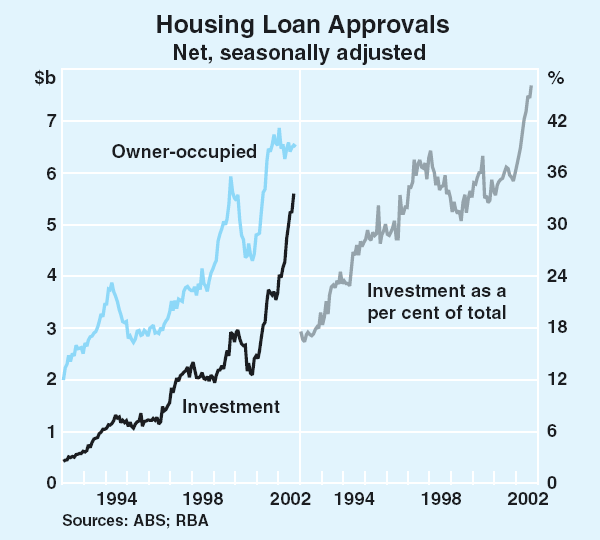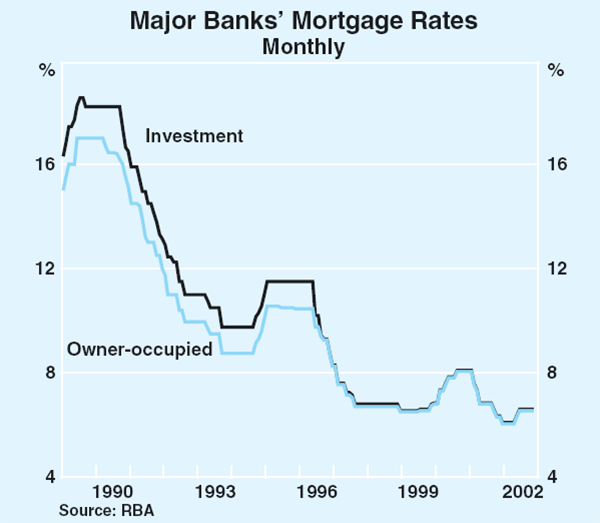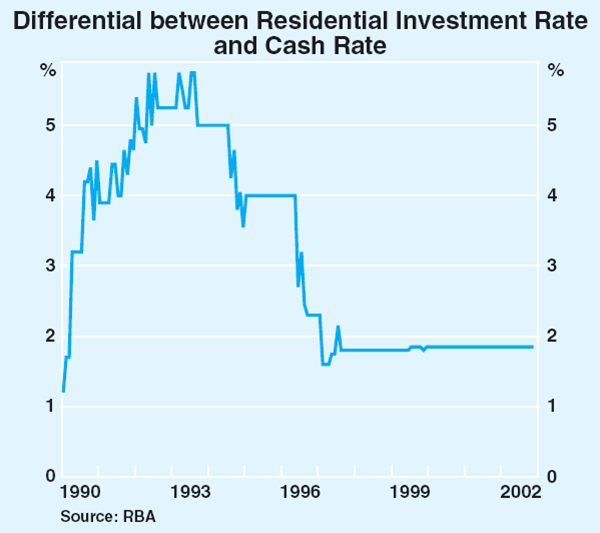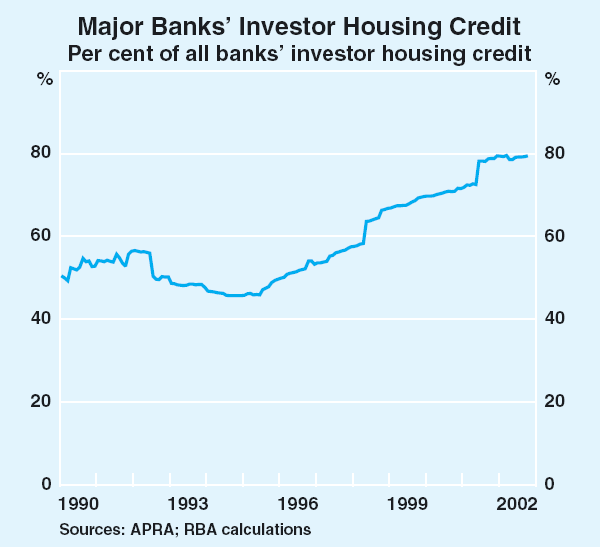Bulletin – December 2002 Innovations in the Provision of Finance for Investor Housing
- Download 476KB
Over the past year, there has been a very sharp rise in loan approvals for investors in housing, with the result that investors now account for over 40 per cent of all housing loans approved.[1] This represents the continuation of a decade-long trend which has seen the share of investor loans in total housing loans more than double since the early 1990s (Graph 1).

This strong growth in borrowing by investors reflects both demand and supply factors. On the demand side, there has always been a large number of investors who were keen to borrow to purchase rental properties. Traditionally, the rental income was a relatively small part of the attraction: prospective capital gains and the ability to negatively gear for tax effectiveness have always been the major incentives for this type of investment. While the public's desire to acquire investor housing was always strong, the extent to which it could actually be realised was limited by the availability of finance. Many lending institutions were not very interested in providing finance for investor housing, and the lending products available were often expensive, inconvenient or hard to acquire. Over the course of the 1990's, however, this progressively changed and the supply of finance increased markedly, making geared investment in rental properties available to a much wider cross-section of the public than formerly.
In the 1980s, when the financial sector was initially deregulated, it was the corporate sector that availed itself of the products of financial innovation. As companies' access to debt increased greatly, their gearing rose sharply. In comparison, there was much less innovation in the provision of housing finance. In the 1990s, however, the picture was quite different. Early in the decade, financial institutions were keen to expand their portfolios of relatively high-return low-risk housing loans, particularly given the losses that they had incurred on their corporate loan portfolios. This renewed interest in housing finance, as well as strong competition from new entrants, spurred innovation. Initially, owner-occupiers were the main beneficiaries, but since the mid 1990s, a number of the innovations in housing finance have specifically benefited investors.
Pricing and Loan Origination
Perhaps the most obvious evidence of a change in the banks' attitude towards investor housing is the elimination in 1996 of the interest surcharge on loans to investors (Graph 2). Prior to 1996, banks put more onerous conditions on investors than owner-occupiers and typically charged them an interest rate 1 percentage point above that charged to owner-occupiers. The elimination of this surcharge was in addition to the general decline in interest margins that occurred over the first half of the 1990s. As a result, by early 1997, the average margin between the investment loan rate and the RBA's cash rate had fallen to around 1¾ per cent, down from around 5½ per cent in 1992 (Graph 3).


An important catalyst for this reduction in margins was the entry of specialist mortgage originators (also known as mortgage managers) into the mortgage market in the early 1990s. Given the high margins at the time, housing loans were extremely profitable. Existing lenders were competing for new business by offering ‘honeymoon loans’ on which a discounted interest rate was charged for the first year, but they were reluctant to lower their standard variable rates to attract new business as this would have meant also lowering the interest rate on existing loans. In contrast, the specialist mortgage originators, which did not have existing customers, were able to compete aggressively, offering standard variable mortgage rates around 1 to 1½ percentage points below those offered by the established lenders. Moreover, in contrast to the practice of the existing lenders, a number of the originators charged the same interest rate and offered the same terms and conditions to investors as to owner-occupiers.
The existing lenders responded to this competition by offering both owner-occupiers and investors enhanced lending products. Eventually, though, they too cut their margins. The elimination of the investor surcharge also reflected the accumulating evidence that credit losses on loans to investors had not been materially different from those on loans to owner-occupiers. Banks, in particular, became keen not to miss out on the fastest growing part of the mortgage market. Reflecting this, at various times over recent years a number of banks have conducted extensive advertising campaigns in an effort to increase the number of investor home loans on their balance sheets. In this they have been successful, with investor housing now accounting for over 30 per cent of the major banks' housing loans, compared with 11 per cent in 1990. The major banks have also increased their share of the total investor housing credit market from about 50 per cent in 1990 to nearly 80 per cent in 2002 (Graph 4).

The development of the mortgage broking industry over the past couple of years has added further to the competitive environment for both owner-occupier and investment loans. Mortgage brokers have made it easier to conduct price and product comparisons and their advertising campaigns have increased the public's awareness of the availability of finance. The brokers have also substantially lowered entry costs for new lenders, by reducing the need for extensive branch networks and advertising. While the first broking franchises were established in 1992, it is only in the past few years that they have gained a significant presence in the marketplace, accounting for around 30 per cent of housing mortgages originated in Australia in 2001.
Product Innovation
The increased competition and appetite by financial institutions for housing loans has also led to the introduction of a much wider range of loan products than was available in the 1980s. A number of these products have been designed with investors particularly in mind. These include:
- home equity loans: These loans provide a line of credit secured by a mortgage against an existing property. They thus allow equity in an owner-occupied property to be made available for the purchase of an investment property. Home equity loans can also be used for other purposes and have partly taken the place of unsecured personal loans. In some cases no repayments are required provided that the size of the outstanding debt remains below an agreed limit (generally up to 80 per cent of the value of the property). Currently, home-equity-type loans account for around 14 per cent of loans outstanding that are secured by residential property.
- split-purpose loans: These loans allow a borrower to split a loan into two sub accounts, one for a home loan and the other for an investment loan. In the initial years all loan repayments may be directed to the home loan account, with the interest due on the investment loan being capitalised. The first such loans were introduced by a non-bank lender in 1996 and have subsequently been offered by some banks. They are marketed to investors as offering significant tax savings by allowing interest charges on the capitalised interest to be tax deductible. The Australian Tax Office is, however, currently challenging the validity of this tax deduction.
- deposit bonds: These bonds remove the need for a purchaser of a property to pay a deposit at the time contracts are exchanged. Instead, the issuer of the bond (typically an insurance company) guarantees that an amount equivalent to the deposit will be paid at settlement. In return for the guarantee, the purchaser pays the issuer a fee. For short-term bonds this can be measured in hundreds of dollars rather than the tens of thousands that is required for a conventional deposit. Long-term deposit bonds (with terms of up to three years) are used by investors to purchase property ‘off-the-plan’. Even on these, the fee is much smaller than the traditional 10 per cent deposit, allowing the investor to gain a highly leveraged exposure to the property market during the construction phase of the property. While there are no comprehensive data on their usage, developers report that deposit bonds have been used by up to 70 per cent of purchasers in some projects. It is estimated that they are used in about 20 per cent of Sydney residential transactions, the market where their use is most widespread.
- interest only loans: These loans have a longer history than some of the other innovations directed at investor housing. They are popular as they allow continuing large tax deductions by way of negative gearing. They also mean that less of the investor's cashflow is tied up servicing the loans and can be used for other purposes. Some lenders now do not require any principal repayment for 20 years, although a 5-year period is still the most common. Most lenders now also offer loans on which one year's interest can be paid in advance, thereby allowing the investor to bring forward the tax-deductible interest payments. These loans provide some limited year-to-year flexibility as to the timing of interest deductions, which can lead to a smoother income pattern and lower taxation. Some lenders provide a discount of around 20 basis points on fixed-rate loans on which interest is prepaid.
There have been a number of other innovations that, while not developed with investors specifically in mind, have given both investors and owner-occupiers considerably greater flexibility. These products have, at the margin, also increased access to credit and/or reduced the cost of borrowing. They include:
- non-conforming loans: These loans are provided by specialist mortgage originators to borrowers who do not meet the banks' standard lending criteria. Such borrowers typically either have poor credit histories (including inadequate financial documentation) or are seeking a loan with a very high loan-to-value ratio, generally above 95 per cent. Given the relatively high level of risk associated with these loans they attract higher interest rates than those on traditional mortgages. The first specialist non-conforming mortgage provider entered the Australian market in 1997. Currently, non-conforming loans account for between 2 and 4 per cent of loans written.
- redraw facilities and offset accounts: These arrangements allow borrowers to access loan repayments that have been made in excess of the minimum repayments required by the lender. As such they reduce the need for borrowers to maintain precautionary savings in low-interest deposit accounts and can offer a tax efficient form of saving. The most flexible of such arrangements combine a home loan account, a transactions account and credit card account into the one facility.
- fixed-rate loans: This type of loan virtually disappeared from the Australian market during the high-inflation years of the 1970s and 1980s, but was re-introduced in the early 1990s with some lenders offering terms of up to ten years, although one to five years is more common. By the mid 1990s, fixed-rate loans accounted for nearly 30 per cent of loans outstanding, although with interest rates on variable rate loans being steadier in recent years, this share has subsequently fallen to around 15 per cent. Many lenders now also offer split-rate loans that allow the borrower to specify the share of the loan bearing a fixed rate and that carrying a variable rate. In a similar vein, borrowers can also split their loan between a no-frills loan and a standard loan with the associated features and interest rates separately applying to each component.
Conclusion
These supply-side influences have had an important influence on the growth of borrowing by investors. Financial institutions have considerably increased their appetite for investor housing loans in recent years and, reflecting this, have developed and marketed loan products specifically for investors. Together with more competitive pricing, this has considerably increased the availability of finance to investors. In a macroeconomic and financial environment that has been favourable for the housing market, investors have taken advantage of this to sharply increase their borrowing.
Footnote
For further details see ‘Recent Developments in Housing: Prices, Finance and Investor Attitudes’, Reserve Bank of Australia Bulletin, July 2002, pp 1–6. [1]